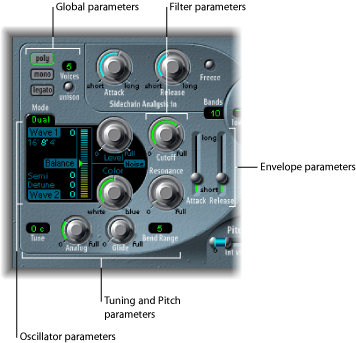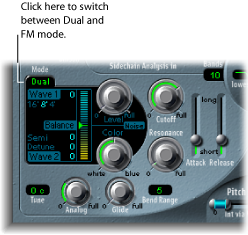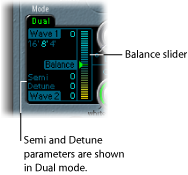EVOC 20 PolySynth Synthesis Section Parameters
The EVOC 20 PolySynth is equipped with a polyphonic synthesizer. It is capable of accepting MIDI note input. The parameters of the Synthesis section are described below.

- Oscillator parameters: Used to choose the basic waveforms for the synthesis engine of the EVOC 20 PolySynth. See EVOC 20 PolySynth Oscillator Parameters.
- Tuning and Pitch parameters: Control the overall tuning of the synthesizer, and aspects such as pitch bend and portamento. See EVOC 20 PolySynth Tuning and Pitch Parameters.
- Filter parameters: Used to shape the basic waveforms of the oscillators. See EVOC 20 PolySynth Filter Parameters.
- Envelope parameters: Provide level control of the attack and release phases of the synthesizer sound. See EVOC 20 PolySynth Envelope Parameters.
- Global parameters: The parameters at the top left of the interface determine the keyboard mode and number of voices used by the EVOC 20 PolySynth. See EVOC 20 PolySynth Global Parameters.
EVOC 20 PolySynth Oscillator Parameters
The EVOC 20 PolySynth has two oscillators, which you can switch between Dual mode and FM mode:

- Dual mode: Each oscillator allows you to choose a digital waveform.
- FM mode: Oscillator 1 generates a sine wave. The frequency, or pitch, of Oscillator 1 is modulated by Oscillator 2 (for information about FM synthesis, see Frequency Modulation (FM) Synthesis). This leads to a number of different tones and harmonics becoming audible. Oscillator 2 can use any of the digital waveforms.
Each mode subtly changes the parameters shown in the Oscillator section.
The Synthesis section also incorporates a noise generator, which can add a further color to your sound. See the following for information on Dual mode, FM mode, and Noise generator mode:
Dual Mode EVOC 20 PolySynth Oscillator Parameters
FM Mode EVOC 20 PolySynth Oscillator Parameters
EVOC 20 PolySynth Noise Generator Parameters
Common EVOC 20 PolySynth Oscillator Parameters
This section describes parameters common to both Dual and FM modes.
Dual Mode EVOC 20 PolySynth Oscillator Parameters
In Dual mode, each oscillator can use any of 50 digital waveforms.

FM Mode EVOC 20 PolySynth Oscillator Parameters
When in FM mode, Oscillator 1 generates a sine wave. The Wave 1 parameter has no effect in this mode.

EVOC 20 PolySynth Noise Generator Parameters
The noise generator provides a further sound source that can be used alongside the two oscillators.

Important: The noise generator in the Oscillator section is independent of the noise generator in the U/V Detection area. For further information about voiced and unvoiced signals, see EVOC 20 PolySynth (U/V) Detection Parameters.
- Color knob: Controls the timbre of the noise signal. At the full-left position, the noise generator creates pure white noise. At the full-right position, you hear blue noise (high-passed noise). White noise has always been used to create wind and rain sound effects. It has the same energy in each frequency interval. Blue noise sounds brighter, because its bass portion is suppressed by a highpass filter.
Tip: Set Color to the full-right position and Level to a very low value to achieve a more lively and fresh synthesis signal.
EVOC 20 PolySynth Tuning and Pitch Parameters
The parameters at the lower left of the interface are used to control the overall tuning and other pitch-related aspects of the EVOC 20 PolySynth sound.

- Glide knob: Determines the time it takes for the pitch to slide from one note to another—portamento. (For information about mono and legato, see EVOC 20 PolySynth Global Parameters.)
EVOC 20 PolySynth Filter Parameters
The EVOC 20 PolySynth synthesis section has a simple lowpass filter. The filter is used for rough signal shaping, before the signal is more precisely shaped by the individual bands of the Formant Filter banks.

EVOC 20 PolySynth Envelope Parameters
The EVOC 20 PolySynth features a simple Attack/Release envelope generator, which is used to control the level of the oscillators over time.

EVOC 20 PolySynth Global Parameters
The parameters at the top left of the interface determine the keyboard mode and number of voices used by the EVOC 20 PolySynth.

- Mono/Legato buttons: When Mono or Legato is selected, the EVOC 20 PolySynth is monophonic, and uses a single voice.
In Legato mode, Glide (see EVOC 20 PolySynth Tuning and Pitch Parameters) is only active on tied notes. Envelopes are not retriggered when tied notes are played (single trigger).
In Mono mode, Glide is always active and the envelopes are retriggered by every note played (multi trigger).
- Unison button: Enables or disables Unison mode.
In Unison/Poly mode—where both the Unison and Poly buttons are active—each EVOC 20 PolySynth voice is doubled, which cuts polyphony in half (to a maximum of 8 voices, shown in the Voices field). The doubled voices are detuned by the amount defined with the Analog knob.
In Unison/Mono mode—where both the Unison and Mono or Legato buttons are active—up to 16 voices can be stacked and played monophonically. The Voices field displays the number of stacked voices that will be heard.
Important: Stacking voices in Unison/Mono mode significantly increases the EVOC 20 PolySynth’s output volume. To avoid overloading the instrument channel strip output, you should initially set a low Level slider value and gradually bring it up (see EVOC 20 PolySynth Output Parameters).